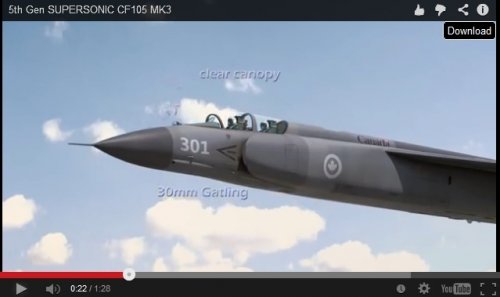- Joined
- 3 June 2006
- Messages
- 2,964
- Reaction score
- 3,235
Avro Arrow Bourdeau Industries CF-105 MK3, a 5th Gen supersonic fighter concept.
Cool, but I would prefer, that the advanced long to medium AA missiles should be stored internal in the weapons bay.
http://youtu.be/1UmDYc8s3YYThe Mk3 is a direct descendant of the original Avro Arrow MK1/MK2 of 1956-59 which was arbitrarily cancelled by the Government of Canada in February 1959.
This 21st Century platform incorporates "next gen" avionics, electronics, materials, manufacturing and assembly processes and is NOT limited to the technologies of its predecessor. The airframe achieved aerodynamic performance during testing in 1958-59 significantly exceeding original MK1 objectives and was to be further developed over several generations to realize its full potential.
The MK3 also incorporates battle tested weaponry (i.e. 30mm Gatling gun, IR targeting pod, etc.) as well as the next generation BVR/WVR air to air (AAM) missiles. The 5th Gen electronics (AESA, QWIP/IRST, data links, etc.) suite ensures 21st century interoperability with allies latest technologies but possesses aerodynamic performance far in excess of current and near future opponents.
The CF105 was designed to specifically meet the future all-weather air defense sovereignty requirements of Canada's homeland territories with 21st century Iroquois lll propulsion (once again a generational 30% improvement over the Iroquois ll), the Mach 3.5 MK3 is also a multi-role platform capable of full ground attack bombing missions.
It has been re-engineered to deliver air dominance performance specific to Canada's air defense requirements.
This Made in Canada weapons system has, to date, been specifically excluded from the selection process restricted to 4 foreign manufacturers invited exclusively to be evaluated by PWGSC procurement.
A dedicated team at Bourdeau Industries continues to develop and position this platform with the expectation of competing at some point in the not too distant future.
See Facebook at "Avro Arrow Bourdeau Industries - (Official)" for more detailed information.
Code:
http://youtu.be/1UmDYc8s3YYCool, but I would prefer, that the advanced long to medium AA missiles should be stored internal in the weapons bay.


